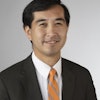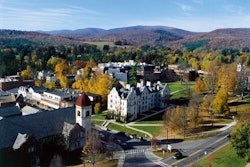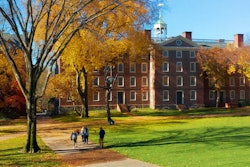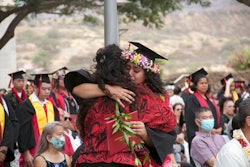Swept Into the Background
Scholars say that distrust of government officials by Vietnamese hurricane evacuees may have had its roots in the Black community.
By Lydia Lum
The entire world saw the images of Black New Orleans residents left homeless, jobless and helpless by the arrival and aftermath of Hurricane Katrina. The pictures and stories dominated mainstream news outlets for weeks.
What hasn’t been widely publicized, however, are the Katrina-related ordeals of Vietnamese Americans, another socio-economically disadvantaged population along the Gulf Coast. While many Blacks sought shelter from rising floodwaters at the New Orleans Superdome, many Vietnamese residents hurried to Houston, home of the largest Vietnamese community in the South. And while Black survivors sought refuge at mammoth shelters like Houston’s Astrodome, Vietnamese evacuees instead looked for help from their own. The location of choice for many was a Houston shopping center of mostly Asian-owned businesses. In the days and weeks after Katrina, the parking lot of the popular public meeting place morphed into an impromptu staging area.
According to reports, some evacuees slept in their cars for several days before community leaders arrived and referred them to Vietnamese temples, churches and families willing to house them. Houston residents showed up at the shopping strip with donations of food, clothes and cash. Evacuees who had already found refuge in the city returned to the shopping center to learn the latest flood-related news.
Scholars find it not at all surprising that so many Vietnamese, who repeatedly fled turmoil and persecution in their native country, bypassed official channels during the Katrina crisis. The reasons are complex. Yet they illustrate the commonalities Vietnamese share with other minority populations. They also show how two races can enjoy cooperative, interdependent relationships with each other yet simultaneously struggle with hostilities and tension.
A Complex History
According to the 2000 Census, there are more than 1.1 million Vietnamese Americans nationwide. Southern California is home to more than 230,000, making it the largest Vietnamese community outside of Vietnam. Perhaps not surprisingly, the single largest community, in Orange County, Calif., is just an hour away from Camp Pendleton, the Marine Corps base where thousands of Vietnamese refugees were housed in camps after the fall of Saigon in 1975. More than 24,000 Vietnamese live in Louisiana and made up the majority of New Orleans’ Asian American population. Many of those Vietnamese have gained professional visibility in the fishing and shrimping industry, often facing hostility from other Americans in the process. In nearby Galveston, Texas, for instance, the Ku Klux Klan demonstrated against and intimidated Vietnamese fishermen until court orders in the early 1980s stopped them.
Nationally, many Vietnamese moved from the refugee camps to urban, working-class areas, where their neighbors were more often Black and Hispanic than White, Japanese or Chinese. So over the years, Blacks have influenced Vietnamese American life more than Whites, scholars say. Vietnamese youth embraced Black hip-hop culture before most of mainstream America did. Performance poet Bao Phi, for instance, has earned fame in slam competitions with works drawn partly from growing up in a Black neighborhood in Minneapolis.
Vietnamese for years have carved out their living with the help of other minorities, says Dr. Thu-Huong Nguyen-vo, an assistant professor in the Asian languages and culture department at the University of California, Los Angeles. For instance, Vietnamese restauranteurs in Los Angeles often use Asian vendors and suppliers, but rely on Hispanics — who make up one in three Californians — to wash dishes and bus tables, she says. Some restauranteurs buy produce from Mexican farmers. While it’s been a stable business model for years, the practice is laced with inequalities, because dishwashers and other laborers are typically low-paid.
“These ethnic communities are intimately linked, with relationships of solidarity mixed with tension,” Nguyen-vo says.
As is often the case, some of that tension stems from a simple lack of cultural understanding between the groups.
While African-American history has been taught inconsistently in public
schools, Asian American history is often not addressed at all. And some working adults have never had the opportunity to learn either one.
“Surveys showing Vietnamese individuals who don’t know any Blacks can be misleading,” says Dr. Yen Le Espiritu, the University of California, San Diego’s chairwoman of ethnic studies. “The surveys don’t take into account that some people are working 15 hours a day, often more than one job. They don’t have time to socialize.”
Adding to the complexity are language differences. Like most immigrants, Vietnamese are sometimes more confident speaking in their native tongue than in English, despite many of them having lived here for 30 years or more.
Language differences certainly led many Gulf Coast-area Vietnamese to flee to the Houston shopping center rather than the Superdome or other official shelters, academics say. Many Vietnamese Katrina survivors remember how previous mistakes on employment or insurance forms resulted in havoc, says Dr. Linda Trinh Võ, an associate professor in Asian American studies at University of California-Irvine. With those memories in mind, they were convinced the government wouldn’t provide adequate translators to guide them through the maze of bureaucratic paperwork at the designated shelters.
“During emergencies like Katrina, they obviously would prefer fluency in English,” says Võ.
Recognizing that, the Freddie Mac Corp. last month gave a $200,000 grant to three Vietnamese American nonprofit groups to secure bilingual speakers to help displaced people better tap into relief agencies. Bilingual speakers also will encourage some hurricane victims to leave their damaged, unsanitary homes for temporary housing, similar to what has already been offered to other evacuees. Officials say many Vietnamese, as well as Cambodian and Laotian families, stayed in their homes because they did not know how to gain access to the FEMA-provided trailers and housing alternatives.
The distrust of New Orleans officials by the city’s Vietnamese population may have had its roots in the Black community, says Dr. Peter Nien-chu Kiang, director of Asian American studies at the University of Massachusetts-Boston. When officials designated the Superdome as a safe haven, Vietnamese residents seemingly knew what to expect, Kiang says. U.S. Vietnamese have long observed Blacks’ struggles for health care, education and social services. And with Blacks comprising more than 67 percent of New Orleans’ residents, it was presumed the Superdome would become a “Black shelter.”
“The Vietnamese have seen firsthand how Blacks are undersupported day to day,” Kiang says. “They have lived among Blacks in cheap housing and know they have dealt with a constant lack of resources and opportunities. The Vietnamese didn’t believe [Superdome] officials would provide Blacks with adequate services in response to Katrina, so their fate would be the same unless they turned to other Vietnamese.”
Some of the Gulf Coast Vietnamese residents also may have wanted to avoid conflicts altogether, says Võ, a sociologist who studies race relations. Some minority communities felt the United States should have addressed social issues at home before reaching out to South Asian refugees after Vietnam. For nearly 30 years now, Vietnamese and Blacks have been in competition for jobs and education opportunities across the nation. The Vietnamese have maintained from the beginning that they only want a chance to earn a living and educate their children.
“The reality is, there are racial tensions between African-Americans and Vietnamese Americans that existed before the hurricane, and they were likely to be exacerbated as everyone tried finding ways to survive during the disaster. Conflict is understandable,” Võ says.
For the Vietnamese hurricane evacuees, faith-based institutions offered an attractive alternative to the mega-shelters. In Houston, a convent of about 50 Vietnamese Dominican nuns opened their doors to displaced New Orleanians, even though the nuns barely make ends meet themselves. And elsewhere in the city, other Vietnamese churches and temples were also filling up with evacuees.
In Biloxi, Miss., also hard-hit by Katrina, some local Vietnamese chose to sleep on the stone patio of their storm-damaged Buddhist temple rather than at a junior high school offering emergency shelter a few blocks away. Meanwhile, several other Biloxi families, whose homes were uninhabitable, accepted the relocation offer of a Vietnamese priest from Lawrence, Kan.
The fact that so much aid has come from the religious community is testament to the central role it plays in daily Vietnamese American life, experts say. About 50 percent of U.S. Vietnamese are Buddhist and 30 percent Catholic, says Dr. Hien Duc Do, associate professor in sociology at San Jose State University, who has studied how religion impacts immigrants.
The church and temple not only serve as places of worship, but are centers of cultural festivities such as celebrations of New Year, or Tet. Pews overflow at Vietnamese-speaking religious services in San Jose, where approximately one in 12 residents is Vietnamese. For the elderly, they are a way of reconnecting with their mother tongue. For the U.S.-born younger generation, religious institutions offer Vietnamese language classes before or after the worship services. For Vietnamese of all ages, the temple and church are all-in-one outlets for socializing, relaxation and professional networking. In that respect, they are similar to Black churches, Do says. Jennifer Nguyen, a 22-year-old graduate student at the University of Massachusetts-Boston, says her church gave her a strong sense of ethnic identity while growing up in Silver Spring, Md.
The next stage in the lives of the Gulf Coast Vietnamese plays out amid much uncertainty. Hurricanes Katrina and Rita destroyed boats and left the waters an ecological mess. Before the storms, escalating fuel prices as well as competition from shrimp farms overseas — including Vietnam, ironically — were putting serious pressure on independent fisherman and shrimpers of all ethnicities.
“I empathize with my people,” says Do, himself a refugee in 1975. “I’m saddened that so many of them have been swept into the background. The issue over the hurricane victims isn’t a Black/White one. Others are caught in the web.”
© Copyright 2005 by DiverseEducation.com





















